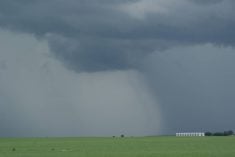Ringworm in cattle is caused by a fungal infection of hair and skin.
Fungi are small plants and include moulds and mushrooms. Several types of fungi affect cattle, the most common being Trichophyton verrucosum, a transmissible infectious disease common in cattle that can also affect people.
The disease typically occurs in young cattle in the winter, where they are housed together in close confinement, especially where there are infected or previously infected cattle. Stress may play a role, because it will suppress the immune system.
Read Also

Higher farmland taxes for investors could solve two problems
The highest education and health care land tax would be for landlords, including investment companies, with no family ties to the land.
As well, younger animals have a relatively weaker immune system than older animals, and may not have been previously exposed to the fungus and thus not have developed the ability to fight off the infection. The fungus may persist in the environment in shed hair and skin for months to years.
Cattle begin to show signs one to four weeks after exposure. Typical lesions are greyish-white raised crusts on the skin. The hair will have fallen out in the affected areas.
Animals can be affected on any part of their body, but most commonly around the eyes and on the head, neck, dewlap and ears. These lesions may be circular and are usually not itchy.
The fungus is spread by direct contact with affected animals or by contact with items contaminated with spores such as bedding, pens, feeders, waterers and equipment. Some animals may also be carriers, which means they shed the fungus but show no signs of being affected.
The disease is usually diagnosed with an exam, which can be confirmed by skin scrapings, cultures and skin biopsies.
Many cases occur in the winter, and animals will usually recover spontaneously one to several months later. The disease’s duration and severity depends on host factors such as nutritional status and the presence of other diseases.
There have been many suggested treatments for ringworm and many appear successful. This is likely because the animals will recover on their own anyway. Treatments include topical application of a weak solution of iodine, human products used to treat
athlete’s foot and topical antifungal drugs.
The medication will be unable to penetrate the crusts, so they should first be brushed or scraped.
Vaccination has been proven widely successful in several
European countries, but does not appear to be available here.
Infected barns should be cleaned with a strong detergent or a bleach and water mixture if possible.
Clean feeders, waterers and anything else that comes into contact with the animals. Starting topical treatment of the lesions in the early stages of the disease will result in a better response.
Reducing animal density and increasing exposure to sunlight will also help prevent spread between animals, and spring turnout will help get rid of the infection.
See a veterinarian for advice specific to the situation.
Daryl Meger is a veterinarian and outdoors enthusiast in a mixed animal practice in Westlock, Alta.














